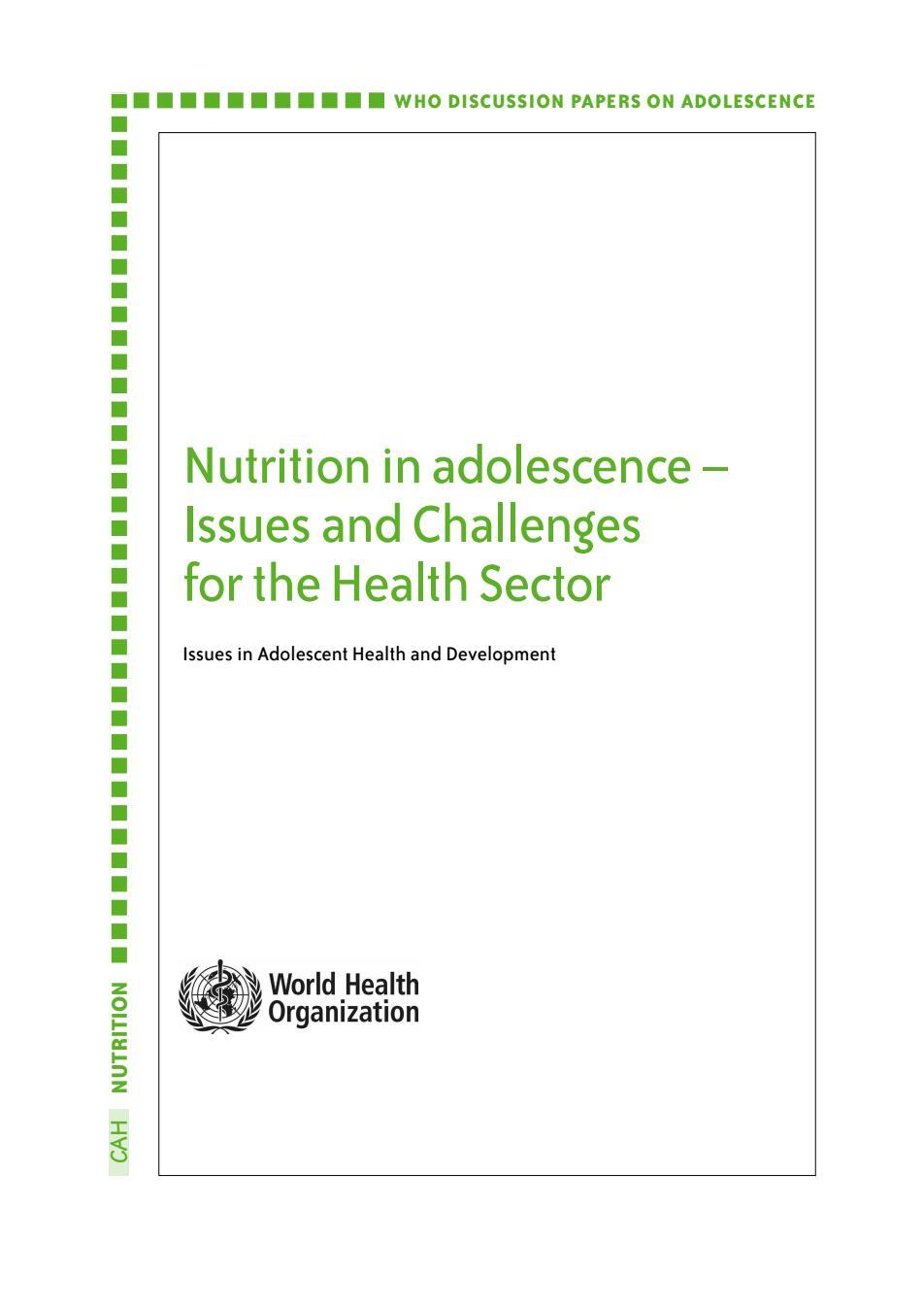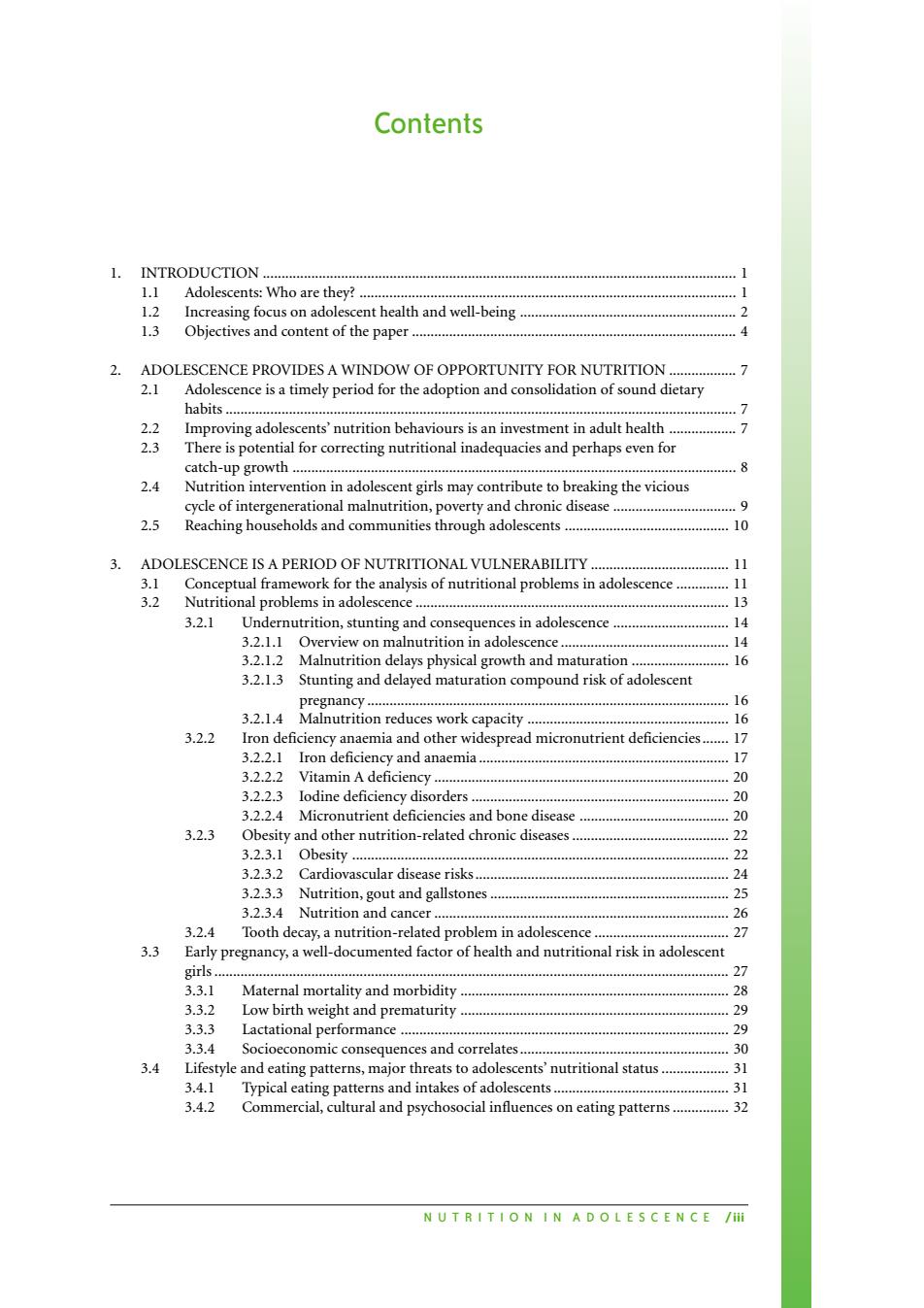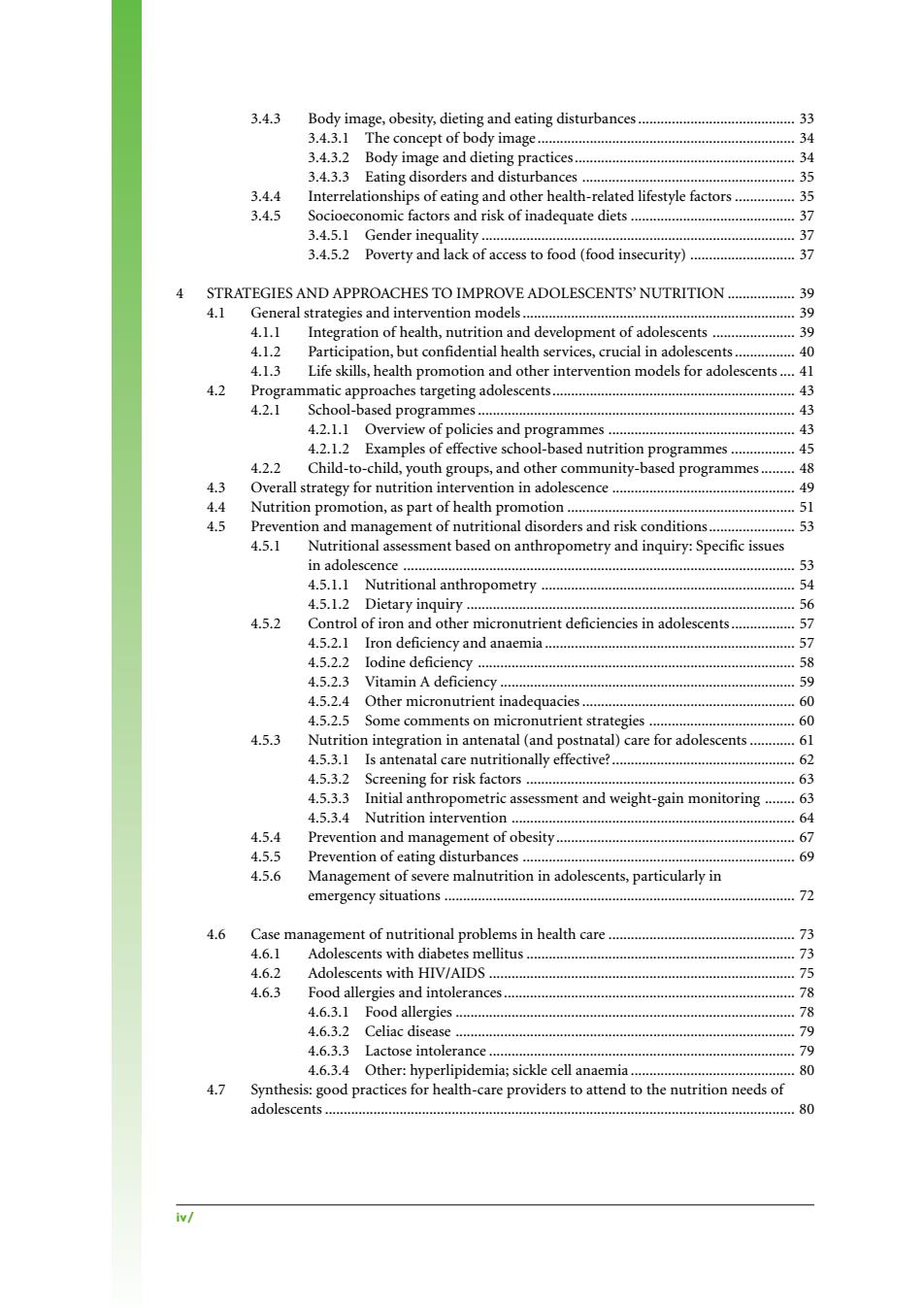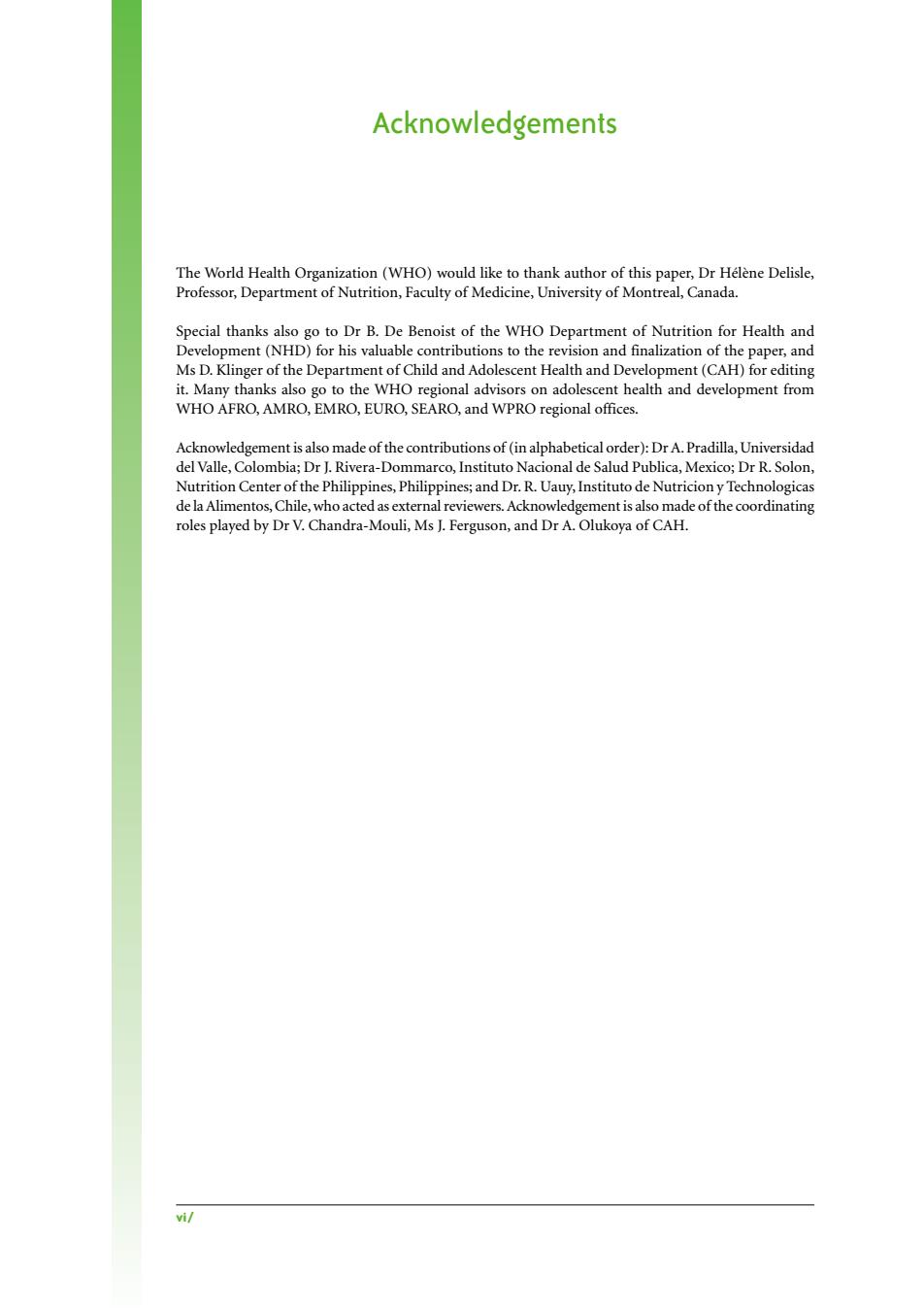
I■■■■■■■■WHO DISCUSSION PAPERS ON ADOLESCENCE Nutrition in adolescence Issues and Challenges for the Health Sector Issues in Adolescent Health and Development World Health Organization HYO
Nutrition in adolescence – Issues and Challenges for the Health Sector Issues in Adolescent Health and Development CAH NUTRITION WHO DISCUSSION PAPERS ON ADOLESCENCE

Contents l.NTRODUCTION… 1.1 Adolescents:Who are they?.............. 1.2 Increasing focus on adolescent health and well-being................. …2 1.3 Objectives and content of the paper. 2.ADOLESCENCE PROVIDES A WINDOW OF OPPORTUNITY FOR NUTRITION ............. 2.1 Adolescence is a timely period for the adoption and consolidation of sound dietary habits …7 2.2 Improving adolescents'nutrition behaviours is an investment in adult health ............. 2.3 There is potential for correcting nutritional inadequacies and perhaps even for catch-upgT0wth…8 2.4 Nutrition intervention in adolescent girls may contribute to breaking the vicious cycle of intergenerational malnutrition,poverty and chronic disease..9 2.5 Reaching households and communities through adolescents...............10 3.ADOLESCENCE IS A PERIOD OF NUTRITIONAL VULNERABILITY.11 3.1 Conceptual framework for the analysis of nutritional problems in adolescence.....11 3.2 Nutritional problems in adolescence.13 3.2.1 Undernutrition,stunting and consequences in adolescence...14 3.2.1.1 Overview on malnutrition in adolescence...............................14 3.2.1.2 Malnutrition delays physical growth and maturation.....16 3.2.1.3 Stunting and delayed maturation compound risk of adolescent pr gnancy.l6 3.2.1.4 Malnutrition reduces work capacity .......... .16 3.2.2 Iron deficiency anaemia and other widespread micronutrient deficiencies.......17 3.2.2.1 Iron deficiency and anaemia.17 3.2.2.2 Vitamin A deficiency20 3.2.2.3 lodine deficiency disorders......... 20 3.2.2.4 Micronutrient deficiencies and bone disease ..............2o 3.2.3 Obesity and other nutrition-related chronic diseases..2. 3.2.31 3.2.3.2 Cardiovascular disease risks.24 3.2.3.3 Nutrition,gout and gallstones......... 25 3.2.3.4 Nutrition and cancer26 3.2.4 Tooth decay,a nutrition-related problem in adolescence........... .27 3.3 Early pregnancy,a well-documented factor of health and nutritional risk in adolescent grlS…,27 3.3.1 Maternal mortality and morbidity28 3.3.2 Low birth weight and prematurity29 3.3.3 Lactational performance ... 29 3.3.4 Socioeconomic consequences and correlates............. 30 3.4 Lifestyle and eating patterns,major threats to adolescents'nutritional status......31 3.4.1 Typical eating patterns and intakes of adolescents.31 3.4.2 Commercial,cultural and psychosocial influences on eating patterns........32 N UTR IT I O N I N A DO L ES C E N C E /ii
N U T R I T I O N I N A D O L E S C E N C E /iii Contents 1. INTRODUCTION ............................................................................................................................... 1 1.1 Adolescents: Who are they? ..................................................................................................... 1 1.2 Increasing focus on adolescent health and well-being .......................................................... 2 1.3 Objectives and content of the paper ....................................................................................... 4 2. ADOLESCENCE PROVIDES A WINDOW OF OPPORTUNITY FOR NUTRITION .................. 7 2.1 Adolescence is a timely period for the adoption and consolidation of sound dietary habits ......................................................................................................................................... 7 2.2 Improving adolescents’ nutrition behaviours is an investment in adult health .................. 7 2.3 There is potential for correcting nutritional inadequacies and perhaps even for catch-up growth ....................................................................................................................... 8 2.4 Nutrition intervention in adolescent girls may contribute to breaking the vicious cycle of intergenerational malnutrition, poverty and chronic disease ................................. 9 2.5 Reaching households and communities through adolescents ............................................ 10 3. ADOLESCENCE IS A PERIOD OF NUTRITIONAL VULNERABILITY ..................................... 11 3.1 Conceptual framework for the analysis of nutritional problems in adolescence .............. 11 3.2 Nutritional problems in adolescence .................................................................................... 13 3.2.1 Undernutrition, stunting and consequences in adolescence ............................... 14 3.2.1.1 Overview on malnutrition in adolescence ............................................. 14 3.2.1.2 Malnutrition delays physical growth and maturation .......................... 16 3.2.1.3 Stunting and delayed maturation compound risk of adolescent pregnancy ................................................................................................. 16 3.2.1.4 Malnutrition reduces work capacity ...................................................... 16 3.2.2 Iron deficiency anaemia and other widespread micronutrient deficiencies ....... 17 3.2.2.1 Iron deficiency and anaemia ................................................................... 17 3.2.2.2 Vitamin A deficiency ............................................................................... 20 3.2.2.3 Iodine deficiency disorders ..................................................................... 20 3.2.2.4 Micronutrient deficiencies and bone disease ........................................ 20 3.2.3 Obesity and other nutrition-related chronic diseases .......................................... 22 3.2.3.1 Obesity ..................................................................................................... 22 3.2.3.2 Cardiovascular disease risks.................................................................... 24 3.2.3.3 Nutrition, gout and gallstones ................................................................ 25 3.2.3.4 Nutrition and cancer ............................................................................... 26 3.2.4 Tooth decay, a nutrition-related problem in adolescence .................................... 27 3.3 Early pregnancy, a well-documented factor of health and nutritional risk in adolescent girls.......................................................................................................................................... 27 3.3.1 Maternal mortality and morbidity ........................................................................ 28 3.3.2 Low birth weight and prematurity ........................................................................ 29 3.3.3 Lactational performance ........................................................................................ 29 3.3.4 Socioeconomic consequences and correlates........................................................ 30 3.4 Lifestyle and eating patterns, major threats to adolescents’ nutritional status .................. 31 3.4.1 Typical eating patterns and intakes of adolescents............................................... 31 3.4.2 Commercial, cultural and psychosocial influences on eating patterns ............... 32

3.4.3 Body image,obesity,dieting and eating disturbances........33 3.4.3.1 The concept of body image34 3.4.3.2 Body image and dieting practices...... 34 3.4.3.3 Eating disorders and disturbances ....... 35 3.4.4 Interrelationships of eating and other health-related lifestyle factors.35 3.4.5 Socioeconomic factors and risk of inadequate diets.37 3.4.5.1 Gender inequality 37 3.4.5.2 Poverty and lack of access to food (food insecurity)..... .37 4 STRATEGIES AND APPROACHES TO IMPROVE ADOLESCENTS'NUTRITION...................39 4.1 General strategies and intervention 4.1.1 Integration of health,nutrition and development of adolescents..... .39 4.1.2 Participation,but confidential health services,crucial in adolescents..............40 4.1.3 Life skills,health promotion and other intervention models for adolescents....41 4.2 Programmatic approaches targeting adolescents.43 4.2.1 School-based programmes 43 4.2.1.1 Overview of policies and programmes...............................43 4.2.1.2 Examples of effective school-based nutrition programmes ...............45 4.2.2 Child-to-child,youth groups,and other community-based programmes........48 4.3 Overall strategy for nutrition intervention in adolescence 49 4.4 Nutrition promotion,as part of health promotion......... 51 4.5 Prevention and management of nutritional disorders and risk conditions...................53 4.5.1 Nutritional assessment based on anthropometry and inquiry:Specific issues in adolescence53 4.5.1.1 Nutritional anthropometry. 54 4.5.1.2 Dietary inquiry... 56 4.5.2 Control of iron and other micronutrient deficiencies in adolescents................. 57 4.5.2.1 Iron deficiency and anaemia .57 4.5.2.2 Iodine deficiency. 58 4.5.2.3 Vitamin A deficiency 59 4.5.2.4 Other micronutrient inadequacies...... 60 4.5.2.5 Some comments on micronutrient strategies 60 4.5.3 Nutrition integration in antenatal (and postnatal)care for adolescents.............61 4.5.3.1 Is antenatal care nutritionally effective?. 62 4.5.3.2 Screening for risk factors........... .63 4.5.3.3 Initial anthropometric assessment and weight-gain monitoring.......63 4.5.3.4 Nutrition intervention. …64 4.5.4 Prevention and management of obesity67 4.5.5 Prevention of eating disturbances.. …69 4.5.6 Management of severe malnutrition in adolescents,particularly in emergency 4.6 Case management of nutritional problems in health care.......73 4.6.1 Adolescents with diabetes mellitus 73 4.6.2 Adolescents with HIV/AIDS5 4.6.3 Food allergies and intolerances8 4.6.3.1 Food allergies 78 4.6.3.2 Celiac disease 79 4.6.3.3 Lactose intolerance.............. .79 4.6.3.4 Other:hyperlipidemia;sickle cell anaemia 80 4.7 Synthesis:good practices for health-care providers to attend to the nutrition needs of adolescents.8 iv/
iv/ 3.4.3 Body image, obesity, dieting and eating disturbances.......................................... 33 3.4.3.1 The concept of body image ..................................................................... 34 3.4.3.2 Body image and dieting practices........................................................... 34 3.4.3.3 Eating disorders and disturbances ......................................................... 35 3.4.4 Interrelationships of eating and other health-related lifestyle factors ................ 35 3.4.5 Socioeconomic factors and risk of inadequate diets ............................................ 37 3.4.5.1 Gender inequality .................................................................................... 37 3.4.5.2 Poverty and lack of access to food (food insecurity) ............................ 37 4 STRATEGIES AND APPROACHES TO IMPROVE ADOLESCENTS’ NUTRITION .................. 39 4.1 General strategies and intervention models......................................................................... 39 4.1.1 Integration of health, nutrition and development of adolescents ...................... 39 4.1.2 Participation, but confidential health services, crucial in adolescents ................ 40 4.1.3 Life skills, health promotion and other intervention models for adolescents .... 41 4.2 Programmatic approaches targeting adolescents................................................................. 43 4.2.1 School-based programmes..................................................................................... 43 4.2.1.1 Overview of policies and programmes .................................................. 43 4.2.1.2 Examples of effective school-based nutrition programmes ................. 45 4.2.2 Child-to-child, youth groups, and other community-based programmes ......... 48 4.3 Overall strategy for nutrition intervention in adolescence ................................................. 49 4.4 Nutrition promotion, as part of health promotion ............................................................. 51 4.5 Prevention and management of nutritional disorders and risk conditions....................... 53 4.5.1 Nutritional assessment based on anthropometry and inquiry: Specific issues in adolescence ......................................................................................................... 53 4.5.1.1 Nutritional anthropometry .................................................................... 54 4.5.1.2 Dietary inquiry ........................................................................................ 56 4.5.2 Control of iron and other micronutrient deficiencies in adolescents................. 57 4.5.2.1 Iron deficiency and anaemia ................................................................... 57 4.5.2.2 Iodine deficiency ..................................................................................... 58 4.5.2.3 Vitamin A deficiency ............................................................................... 59 4.5.2.4 Other micronutrient inadequacies......................................................... 60 4.5.2.5 Some comments on micronutrient strategies ....................................... 60 4.5.3 Nutrition integration in antenatal (and postnatal) care for adolescents ............ 61 4.5.3.1 Is antenatal care nutritionally effective?................................................. 62 4.5.3.2 Screening for risk factors ........................................................................ 63 4.5.3.3 Initial anthropometric assessment and weight-gain monitoring ........ 63 4.5.3.4 Nutrition intervention ............................................................................ 64 4.5.4 Prevention and management of obesity................................................................ 67 4.5.5 Prevention of eating disturbances ......................................................................... 69 4.5.6 Management of severe malnutrition in adolescents, particularly in emergency situations .............................................................................................. 72 4.6 Case management of nutritional problems in health care .................................................. 73 4.6.1 Adolescents with diabetes mellitus ........................................................................ 73 4.6.2 Adolescents with HIV/AIDS .................................................................................. 75 4.6.3 Food allergies and intolerances .............................................................................. 78 4.6.3.1 Food allergies ........................................................................................... 78 4.6.3.2 Celiac disease ........................................................................................... 79 4.6.3.3 Lactose intolerance .................................................................................. 79 4.6.3.4 Other: hyperlipidemia; sickle cell anaemia ............................................ 80 4.7 Synthesis: good practices for health-care providers to attend to the nutrition needs of adolescents .............................................................................................................................. 80

5 CONCLUSIONS AND RECOMMENDATIONS..83 5.1 Adolescents are vulnerable and deserve special attention in nutrition........83 5.2 Need for inclusive strategies and specific policies for adolescent nutrition at country 5.3 Evidence-based strategic orientations ........ .89 5.3.1 Caveat on'evidence-based'decision-making and planning .......89 5.3.2 Primary focus on nutrition promotion,the key role of schools,and the importance of dietary guidelines.90 5.3.3 Adolescent girls as a priority target group,before the first pregnancy.....91 5.3.4 More of an integrated and food-based approach to micronutrient IhalnutFitiODl92 5.3.5 The importance of preventing obesity (and eating disturbances)..93 5.4 Reseatch needs94 5.4.1 On eating behaviours and determinants in adolescents:.94 5.4.2 On nutritional status94 5.4.3 On effectiveness of interventions.95 5.5 Recommendations to WHO for priority action and research........95 5.5.1 Technical Support.95 5.5.2 Research priorities ..... .96 REFERENCES.... 4100 FIGURES 1. Conceptual framework of nutritional problems and causal factors in adolescence........12 2. Overall strategy for nutrition intervention in adolescence5.0 3. A model of eating and weight-related behaviour ......................70 CHARTS 1. Nutrition of adolescents:Good practices for health care providers..81 2. Nutrition intervention:Dealing with adolescents............. .84 APPENDICES: I Nutritional status of adolescents in developing countries.97 0 Selected percentiles of waist circumferences by race,sex,and age......99 NUTRIT I ON IN A DO L E SC E N C E /v
N U T R I T I O N I N A D O L E S C E N C E / v 5 CONCLUSIONS AND RECOMMENDATIONS ............................................................................ 83 5.1 Adolescents are vulnerable and deserve special attention in nutrition .............................. 83 5.2 Need for inclusive strategies and specific policies for adolescent nutrition at country level ......................................................................................................................................... 89 5.3 Evidence-based strategic orientations .................................................................................. 89 5.3.1 Caveat on ‘evidence-based’ decision-making and planning ................................ 89 5.3.2 Primary focus on nutrition promotion, the key role of schools, and the importance of dietary guidelines........................................................................... 90 5.3.3 Adolescent girls as a priority target group, before the first pregnancy ............... 91 5.3.4 More of an integrated and food-based approach to micronutrient malnutrition ............................................................................................................ 92 5.3.5 The importance of preventing obesity (and eating disturbances) ...................... 93 5.4 Research needs........................................................................................................................ 94 5.4.1 On eating behaviours and determinants in adolescents: ..................................... 94 5.4.2 On nutritional status .............................................................................................. 94 5.4.3 On effectiveness of interventions .......................................................................... 95 5.5 Recommendations to WHO for priority action and research ............................................ 95 5.5.1 Technical support ................................................................................................... 95 5.5.2 Research priorities .................................................................................................. 96 REFERENCES........................................................................................................................................... 100 FIGURES 1. Conceptual framework of nutritional problems and causal factors in adolescence ......... 12 2. Overall strategy for nutrition intervention in adolescence ................................................. 50 3. A model of eating and weight-related behaviour ................................................................ 70 CHARTS 1. Nutrition of adolescents: Good practices for health care providers ................................... 81 2. Nutrition intervention: Dealing with adolescents ............................................................... 84 APPENDICES: I Nutritional status of adolescents in developing countries .................................................. 97 II. Selected percentiles of waist circumferences by race, sex, and age ..................................... 99

Acknowledgements The World Health Organization(WHO)would like to thank author of this paper,Dr Helene Delisle, Professor,Department of Nutrition,Faculty of Medicine,University of Montreal,Canada. Special thanks also go to Dr B.De Benoist of the WHO Department of Nutrition for Health and Development (NHD)for his valuable contributions to the revision and finalization of the paper,and Ms D.Klinger of the Department of Child and Adolescent Health and Development(CAH)for editing it.Many thanks also go to the WHO regional advisors on adolescent health and development from WHO AFRO,AMRO,EMRO,EURO,SEARO,and WPRO regional offices. Acknowledgement is also made of the contributions of(in alphabetical order):Dr A.Pradilla,Universidad del Valle,Colombia;Dr J.Rivera-Dommarco,Instituto Nacional de Salud Publica,Mexico;Dr R.Solon, Nutrition Center of the Philippines,Philippines;and Dr.R.Uauy,Instituto de Nutricion y Technologicas de la Alimentos,Chile,who acted as external reviewers.Acknowledgement is also made of the coordinating roles played by Dr V.Chandra-Mouli,Ms J.Ferguson,and Dr A.Olukoya of CAH. vi/
vi/ Acknowledgements The World Health Organization (WHO) would like to thank author of this paper, Dr Hélène Delisle, Professor, Department of Nutrition, Faculty of Medicine, University of Montreal, Canada. Special thanks also go to Dr B. De Benoist of the WHO Department of Nutrition for Health and Development (NHD) for his valuable contributions to the revision and finalization of the paper, and Ms D. Klinger of the Department of Child and Adolescent Health and Development (CAH) for editing it. Many thanks also go to the WHO regional advisors on adolescent health and development from WHO AFRO, AMRO, EMRO, EURO, SEARO, and WPRO regional offices. Acknowledgement is also made of the contributions of (in alphabetical order): Dr A. Pradilla, Universidad del Valle, Colombia; Dr J. Rivera-Dommarco, Instituto Nacional de Salud Publica, Mexico; Dr R. Solon, Nutrition Center of the Philippines, Philippines; and Dr. R. Uauy, Instituto de Nutricion y Technologicas de la Alimentos, Chile, who acted as external reviewers. Acknowledgement is also made of the coordinating roles played by Dr V. Chandra-Mouli, Ms J. Ferguson, and Dr A. Olukoya of CAH